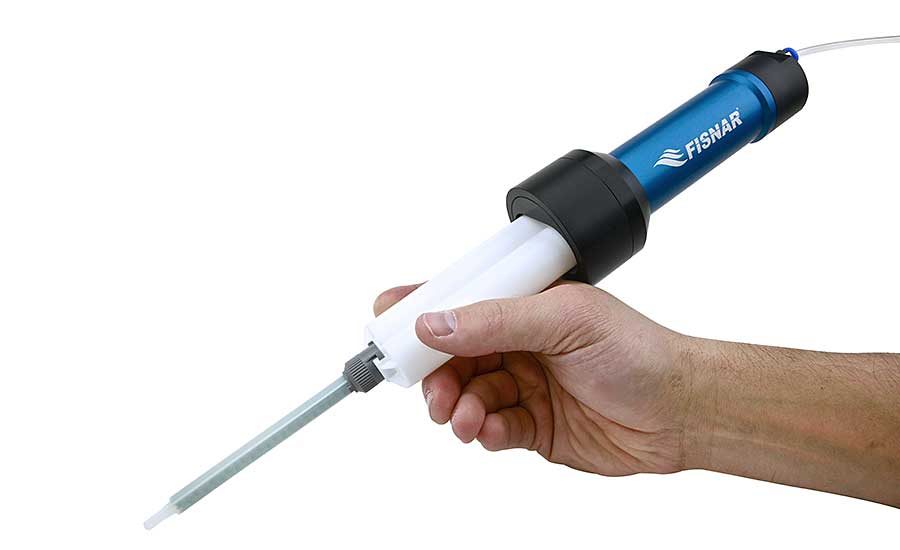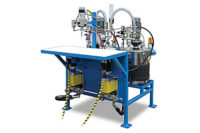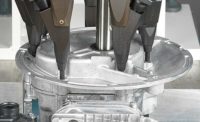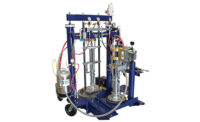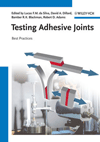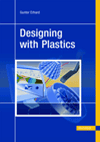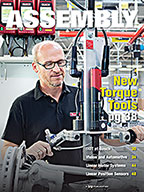Sometimes, it’s hard to beat tried and true classics. That’s why many people quarantined at home during the Great Lockdown turned to old pastimes such as jigsaw puzzles and paint-by-number sets for entertainment.
The same thing can be said about handheld dispensing equipment. There will always be a need for manual tools that can dispense cyanoacrylates, epoxies, urethanes and other types of adhesives.
Robotic dispensing equipment can certainly increase productivity, enhance quality and prevent rejects. But, these capabilities come at a cost that many assembly applications don’t warrant.
For low-volume production, and applications that don’t have critical dispensing specifications, good old-fashioned handheld, powered dispensers provide the answer to many assemblers’ needs.
“Some assembly applications just don’t lend themselves to using automated dispensing equipment,” says Tom Muccino, sales manager at Nordson EFD. “For instance, catheters and IV sets often use delicate parts that require a high degree of touch. Pacemaker leads that use thin-gauge wires are also typically assembled with handheld dispensers.”
“In addition to medical devices, handheld dispensing equipment is popular for applications as diverse as automotive sensors, fiber optic ferrules, signs, speakers, truck trailers and wearable electronic devices,” adds Can La, product manager at Techcon. “We also see a lot of demand in the aerospace industry, where assemblers are working in aircraft fuselages and other tight or confined spaces.”
Handheld dispensers are available in both palm and pistol grip configurations. They range from basic, manual units that rely totally on the operator to control dispensing, to more sophisticated units that allow the user to program dispensing time and pressure settings.
“Manufacturers in all industries are looking for adjustable dispensers that are easy to load and unload, with built-in regulators and visual indicator viewing,” claims Cliff Ellsworth, sales and dispensing product manager at Ellsworth Adhesives. “Universal, one-size-fits-all designs that fit many types of cartridges are becoming more popular. There’s also a trend toward lightweight tools that are ergonomically designed to accommodate many types of operators.”
“The basic dimensions of handheld equipment haven’t changed much in recent years,” adds Omar Regalado, director of global sales at Fishman Corp. “Engineers still have several options to choose from, including dispensing pens and air-powered or positive displacement dispensers.”
Dispensing pens are suitable for manually dispensing continuous beads or applying dots of low-viscosity fluids, such as cyanoacrylates, in noncritical applications. Air-powered dispensers are popular for most handheld applications, because operators can accurately control the amount of adhesive applied within a very reasonable tolerance. Positive displacement dispensers are primarily used for fluids that can change viscosity over time, such as two-part epoxies.
“Manufacturers should always look for ways to dispense smaller quantities of adhesive and more consistently accurate dots,” says Muccino. “However, we’re now seeing more demand for Industry 4.0 technology that enables handheld dispensers to be connected so that engineers can collect and analyze various production parameters. Collecting statistical process control data is increasingly important for quality initiatives in many industries, especially electronics and medical devices.”
That issue is addressed in Nordson EFD’s newest handheld product. The UltimusPlus features a touchscreen display to simplify setup, in addition to providing full lockout of time, pressure and vacuum settings to eliminate dispensing inconsistencies.
“With [Industry 4.0] and advancements in customers’ expectations of equipment [connectivity], our goal was not only to design an easy-to-use dispenser, but also simplify integration with automation to make it the most advanced fluid dispenser on the market,” explains Vladimir Konopelko, global product line manager for dispensers at Nordson EFD.
“Ethernet compatibility simplifies UltimusPlus’ integration with [Industry 4.0] technology,” claims Konopelko. “It allows the dispense cycle to be initiated by a centralized PLC as part of large, in-line operations.”
Engineers at Ellsworth’s Fisnar division are focusing their attention on making handheld dispensers lighter by replacing metal components with high-strength nylon and other material.
One of their newest products is the DTD50, a pneumatically controlled tool for precise dispensing of two-component adhesive packed into 50-milliliter side-by-side cartridges.
“Boasting a weight of just 280 grams, the DTD50 is the industry’s lightest 50-milliliter multi-dispense tool,” claims Ellsworth. “The lightweight, durable design of the DTD50 makes it ideal for handheld use.”

